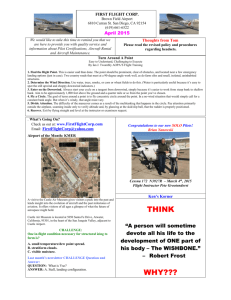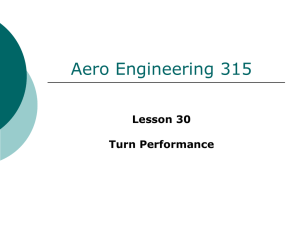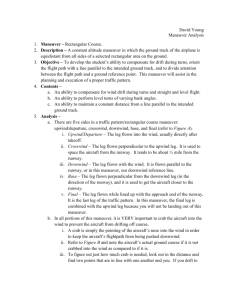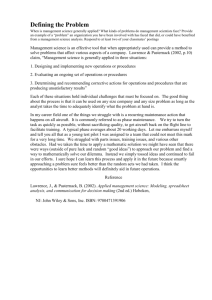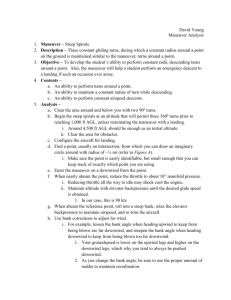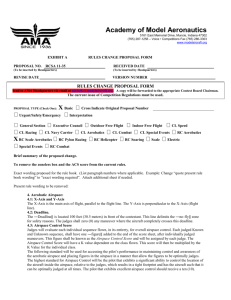X-C-Turns-Around-a-Point
advertisement
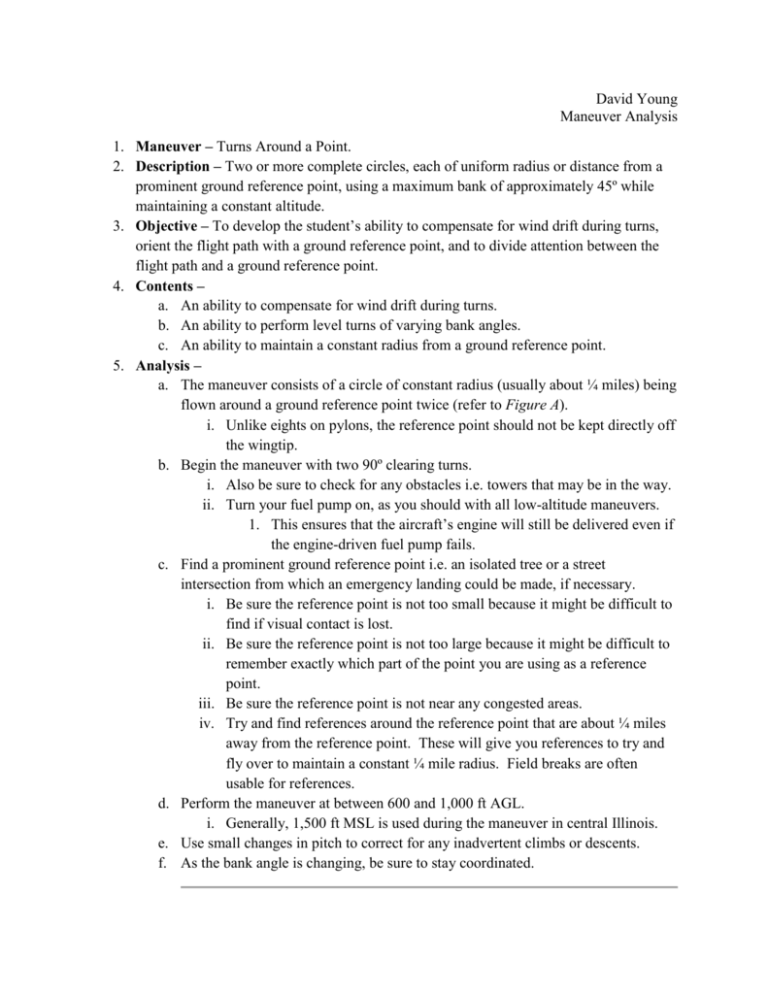
David Young Maneuver Analysis 1. Maneuver – Turns Around a Point. 2. Description – Two or more complete circles, each of uniform radius or distance from a prominent ground reference point, using a maximum bank of approximately 45º while maintaining a constant altitude. 3. Objective – To develop the student’s ability to compensate for wind drift during turns, orient the flight path with a ground reference point, and to divide attention between the flight path and a ground reference point. 4. Contents – a. An ability to compensate for wind drift during turns. b. An ability to perform level turns of varying bank angles. c. An ability to maintain a constant radius from a ground reference point. 5. Analysis – a. The maneuver consists of a circle of constant radius (usually about ¼ miles) being flown around a ground reference point twice (refer to Figure A). i. Unlike eights on pylons, the reference point should not be kept directly off the wingtip. b. Begin the maneuver with two 90º clearing turns. i. Also be sure to check for any obstacles i.e. towers that may be in the way. ii. Turn your fuel pump on, as you should with all low-altitude maneuvers. 1. This ensures that the aircraft’s engine will still be delivered even if the engine-driven fuel pump fails. c. Find a prominent ground reference point i.e. an isolated tree or a street intersection from which an emergency landing could be made, if necessary. i. Be sure the reference point is not too small because it might be difficult to find if visual contact is lost. ii. Be sure the reference point is not too large because it might be difficult to remember exactly which part of the point you are using as a reference point. iii. Be sure the reference point is not near any congested areas. iv. Try and find references around the reference point that are about ¼ miles away from the reference point. These will give you references to try and fly over to maintain a constant ¼ mile radius. Field breaks are often usable for references. d. Perform the maneuver at between 600 and 1,000 ft AGL. i. Generally, 1,500 ft MSL is used during the maneuver in central Illinois. e. Use small changes in pitch to correct for any inadvertent climbs or descents. f. As the bank angle is changing, be sure to stay coordinated. Young 2, X-C g. Enter the maneuver at Va on the downwind about ¼ miles away from the reference point. i. If turning to the left, keep the point on the left side of the aircraft. ii. If turning to the right, keep the point on the right side of the aircraft. iii. In a high wing aircraft, be especially sure the radius is not too large (i.e. more than about ¼ mile). Otherwise the wing will start blocking out the point. h. Roll into a turn around the reference point about 1-2 seconds after the point has disappeared under your wing (if in a low wing aircraft). i. The bank will be the steepest during the turn from downwind because the wind is trying to push you further downwind from the point (higher groundspeed). 1. As bank angle increases, the amount of elevator backpressure needed to maintain altitude increases. 2. NEVER exceed 45º of bank in this maneuver. ii. A steeper bank will keep you from drifting too far downwind. 1. The aircraft has a faster groundspeed when going with the wind, so the amount of ground the aircraft can cover in a given amount of time is increased. Therefore, a steeper bank angle is needed to achieve a higher rate of turn. 2. If you are too far downwind, the reference point will begin slipping away and you will be too far downwind from your ¼ reference. iii. A crab, or turning the aircraft a little into the wind to prevent drifting, will be necessary for all parts of the circle except when going directly into or away from the wind. 1. The crab angle will be at a maximum when perpendicular to the wind. 2. The amount of crab needed depends on the wind, and will vary between 0º - ~10º. The key is to use the amount of crab/bank angle that allows you to overfly the secondary points that are roughly ¼ miles from the reference point. i. As the aircraft begins turning upwind, begin to shallow out the bank and use a little crab to keep the aircraft from being blown too far downwind (lower groundspeed). i. The aircraft has a slower groundspeed when going into the wind, so the amount of ground the aircraft can cover in a given amount of time is reduced. Therefore, a shallower bank angle is needed to decrease the rate of turn. ii. As bank angle decreases, the amount of elevator backpressure needed to maintain altitude decreases. Young 3, X-C iii. Your distance from the reference point can be determined by how far upwind or downwind you are from the ¼ mile reference. iv. If the aircraft is too close to the point, shallow out the bank. v. If the aircraft is too far from the point, steepen the bank, but do not exceed 45º. j. As the aircraft begins to turn downwind again, follow the previous steps from before to go once more around the circle. k. Once two revolutions have been completed (or however many are specified by the instructor or examiner), climb away at Vy on the entry course. 6. Visual Cues – a. Use ¼ mile secondary references around the reference point to help maintain a constant radius. b. To determine if your radius is too large or small, check if you are too far upwind/downwind of your reference. c. The engine cowling and horizon sight picture will continually change as your bank angle and crab changes. 7. Instrument Cues – a. The inclinometer can be used to coordinate the aircraft. b. The altimeter can be used to determine level flight. 8. PTS Standards – a. Private Pilot – i. Exhibits knowledge of the elements related to turns around a point. ii. Selects a suitable ground reference point. iii. Plans the maneuver so as to enter left or right at 600 to 1,000 feet (180 to 300 meters) AGL, at an appropriate distance from the reference point. iv. Applies adequate wind-drift correction to track a constant radius turn around the selected reference point. v. Divides attention between airplane control and the ground track while maintaining coordinated flight. vi. Maintains altitude, ±100 feet (30 meters); maintains airspeed, ±10 knots. b. Commercial Pilot – None Specified. 9. Common Errors – a. Uncoordinated flight. b. Fault entry procedure. c. Poor division of attention. d. Improper correction for wind drift. e. Failure to maintain a constant radius. f. Failure to maintain altitude. g. Failure to select a ground reference point where there is no suitable emergency landing area within gliding distance. 10. References – a. AFH, Ch. 6 Young 4, X-C b. Gleim’s Flight Instructor Flight Maneuvers, Part II, Unit X Young 5, X-C Figure A
